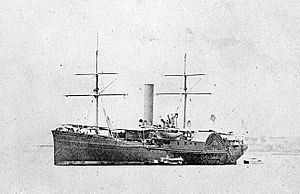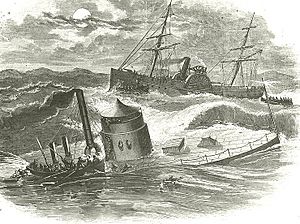USS Rhode Island (1860) facts for kids

The only known photo of the USS Rhode Island, taken in 1866.
|
|
Quick facts for kids History |
|
|---|---|
| Name | USS Rhode Island |
| Laid down | 1860, as John P. King |
| Launched | 6 September 1860 |
| Acquired | by purchase, 27 June 1861 |
| Commissioned | 29 July 1861 |
| Decommissioned | 21 April 1864 |
| Renamed |
|
| Commissioned | 3 October 1864 |
| Decommissioned | 1867 |
| Renamed | Charleston, 8 November 1867 |
| Fate |
|
| General characteristics | |
| Type | Steamer |
| Displacement | 1,517 long tons (1,541 t) |
| Length | 236 ft 2 in (71.98 m) |
| Beam | 36 ft 8 in (11.18 m) |
| Draft | 15 ft (4.6 m) |
| Propulsion | Steam engine |
| Speed | 16 knots (30 km/h; 18 mph) |
| Complement | 257 officers and enlisted |
| Armament |
|
The USS Rhode Island was a special kind of ship called a side-wheel steamer. It joined the United States Navy in 1861.
This ship was first built in New York City in 1860. Its original name was John P. King. After a fire, it was rebuilt and renamed Eagle in 1861. The U.S. Navy bought the ship on June 27, 1861. It was then renamed Rhode Island. The ship officially started its Navy service on July 29, 1861, at the New York Navy Yard. Commander Stephen D. Trenchard was its first captain.
Contents
Serving During the Civil War
A Busy Supply Ship
During the American Civil War, the Rhode Island was a very important supply ship. It traveled to many ports and ships. It delivered mail, money for sailors, medical supplies, and other important items.
Its first trip began on July 31, 1861. While sailing near Galveston, Texas, the Rhode Island caught a small ship called the Venus. This ship was trying to sneak past the blockade with lead, copper, and wood. For the rest of 1861 and 1862, the Rhode Island kept up its vital support work. On one trip in early 1862, it supplied 98 different ships. On another trip, it supplied 118 ships.
The Rhode Island also helped the Gulf Blockading Squadron. On July 4, 1862, it chased a British ship called Richard O'Bryan. The Richard O'Bryan was trying to break the blockade. The Rhode Island forced it to run aground near San Luis Pass.
Helping the Famous Monitor
Later, the Rhode Island had a new job: towing other ships. It helped pull several monitor warships south. These monitors were special ships with very low sides.
On December 29, 1862, the Rhode Island was towing the famous USS Monitor. Another ship, the USS Passaic, was sailing with them. As they sailed around Cape Hatteras, a big storm hit. The Monitor's pumps could not keep up with the water flooding in. The crew had to leave the ship.
Before everyone could get off the Monitor and onto the Rhode Island, the ironclad ship sank. Four officers and 12 sailors were lost. The Rhode Island stayed nearby to mark where the Monitor sank. This spot was about 20 miles (32 km) south-southwest of Cape Hatteras. Seven brave crew members from the Rhode Island received the Medal of Honor for their actions during this rescue.
Enforcing the Blockade
In January 1863, the Rhode Island went to the West Indies. It was looking for two Confederate ships, the Oreto and the Alabama. It didn't find them, but it did force another blockade runner, the Margaret and Jessie, ashore on May 30.
The Rhode Island continued patrolling the Atlantic coast. On August 16, it captured another British ship, the Cronstadt. This ship was carrying cotton, turpentine, and tobacco. It was caught north of Man of War Bay in the Abaco, Bahamas.
Becoming a Cruiser
The Rhode Island's boilers needed fixing. So, on March 28, 1864, it went to the Boston Navy Yard. It was taken out of service on April 21. The ship was changed a lot to become an auxiliary cruiser. It was given powerful new guns. These included one large 11-inch gun, eight 8-inch guns, and two smaller rifles.
The Rhode Island started service again on October 3, 1864. It joined the North Atlantic Blockading Squadron. Its job was to patrol the coasts controlled by the Confederates. On December 1, 1864, it captured another British blockade runner, the Vixen.
The Rhode Island also took part in the attacks on Fort Fisher. It was there for the first attack on December 24, 1864. It also helped in the second, successful attack from January 13-15, 1865. Signal Quartermaster Charles H. Foy earned the Medal of Honor for his bravery at the Second Battle of Fort Fisher.
After the war, the Rhode Island helped bring a powerful former Confederate ship, the Stonewall, to the United States. It sailed to Havana and returned with the Stonewall on November 23.
After the Civil War
The Rhode Island continued to sail in the Atlantic and West Indies throughout 1866. From April 1866, it was the flagship for Rear Admiral James S. Palmer. On January 15, 1866, Seaman William B. Stacy received the Medal of Honor. He saved a drowning shipmate in the harbor of Cap-Haïtien, Haiti.
The Rhode Island visited Halifax in 1867. It was then taken out of service. The ship was sold on October 1, 1867, to G. W. Quintard. It was renamed Charleston on November 8, 1867. The side-wheel steamer continued to work as a merchant ship until 1885, when it was no longer used.


